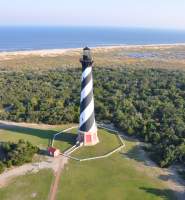Salvo, NC
At first glance, the villages of Rodanthe, Waves and Salvo seem to be one town. In fact, many folks – locals and visitors alike – call them “The Tri-Villages.” Their borders touch and one village appears to run seamlessly into the next, but to many – locals and longtime visitors alike – the villages are distinct places, each with a unique identity, history and personality. Why do the three villages appear to be one? A local legend says there was a time you could tell the three apart, but you needed the village limit signs to do so. That same legend claims surfers or beach loving vacationers wanted a souvenir to take home, so they stole the “Welcome to Waves” sign every time a new one went up until the powers that be decided to remove the signs permanently. Rodanthe? Waves? Salvo? What’s with the strange names? There are stories behind those names and the names these villages used to go by and you’ll learn those soon. What’s the difference between the villages? Let’s find out.
For a good part of its history, Salvo, the southernmost and third of the Tri-Villages, was home to fish houses like Rodanthe to the north, but little else in terms of industry. Initially called Clarks, the name is said to have changed during the Civil War when a Union gunboat commander spied a cluster of buildings on Hatteras Island. Looking on maps, he and his men couldn’t find a named settlement, but the commander said, “Give it a salvo anyway.” They did and someone marked “Salvo” on the map and that’s been the name ever since. Supposedly. Officially it was named Salvo in 1901 when the post office – a tiny one – opened. At only 8’x10’ or 12’ it was just big enough to move into the yard of whoever happened to be Postmaster at the time. From 1901 to its decommissioning in 1988, it held the title “Smallest Post Office” and was frequently mistaken by visitors for an information booth or a restroom.
In Salvo, a few tackle shops and small grocers can help you get outfitted for a day or two on the water or at your rental home or campsite, but a full-service grocery store is a short drive away – south to Avon or north of Whalebone Junction. Rental homes and campgrounds provide visitors with options for where to stay, supported by a number of great restaurants and cafes in the Tri-Village area.
Immediately south of Salvo awaits an uninhabited 11.5-mile section of the Cape Hatteras National Seashore. The Salvo Day Use Area and other pull-offs and ORV (Off-Road Vehicle) ramps provide access to the Pamlico Sound and drive-on access to the beach. Most ocean-side ORV ramps have a small parking area and a boardwalk or path to the beach. The Salvo Day Use Area has more to offer – restrooms and changing facilities, a picnic area, and a few grills – and it’s a great place for sunsets. As you continue south towards Avon, you’ll find several ORV ramps accessing the beach and Sound, and you may even see a few kiteboarders skimming across the surface of the Pamlico Sound. For more information on ORV ramps- beach driving in the Cape Hatteras National Seashore requires an ORV permit from Recreation.gov and nearby recreation opportunities.
Explore More of Salvo
5 Shipwrecks You Can Visit Along the Outer Banks's Coast
The Outer Banks of North Carolina has a reputation of being the Graveyard of the Atlantic, and there are estimates...
Read MoreIslands of the Outer Banks: Which one is right for you?
Seaside destinations tend to pack tons of tourists onto overcrowded beaches, but not in the Outer Banks of North...
Read MoreCamping On the Outer Banks, NC
For many, the thought of a vacation to North Carolina’s Outer Banks sounds relaxing and fun-filled. The area...
Read More


















